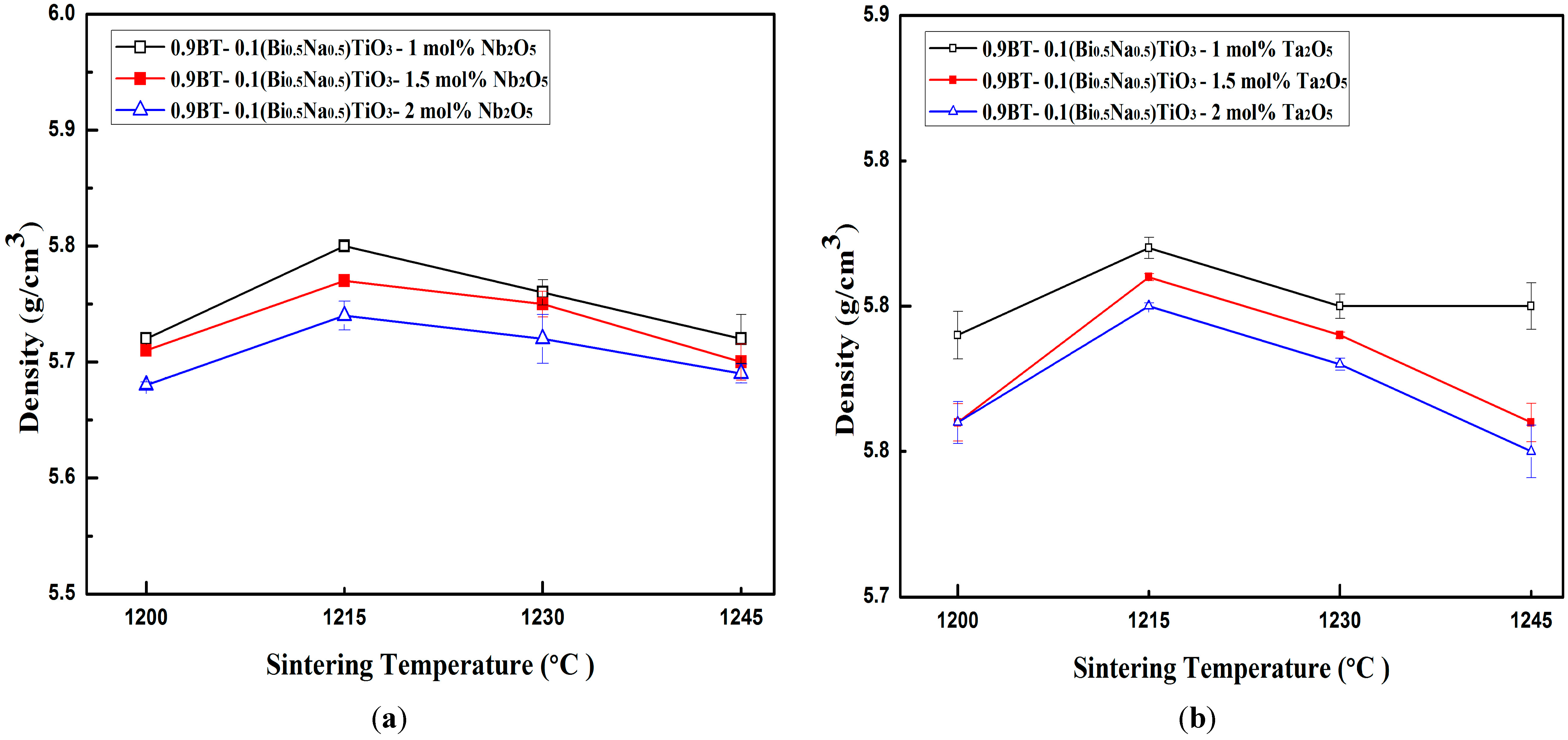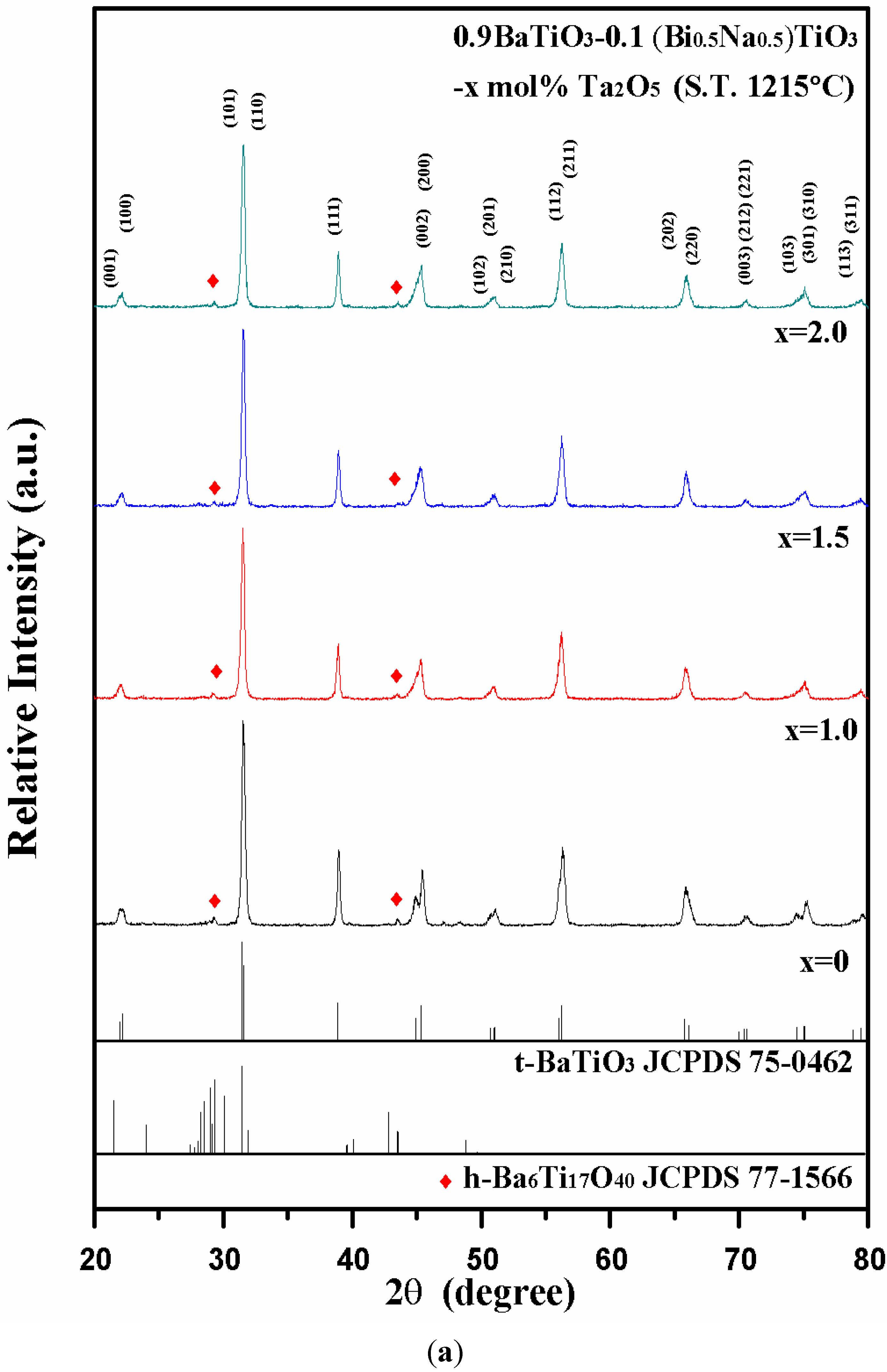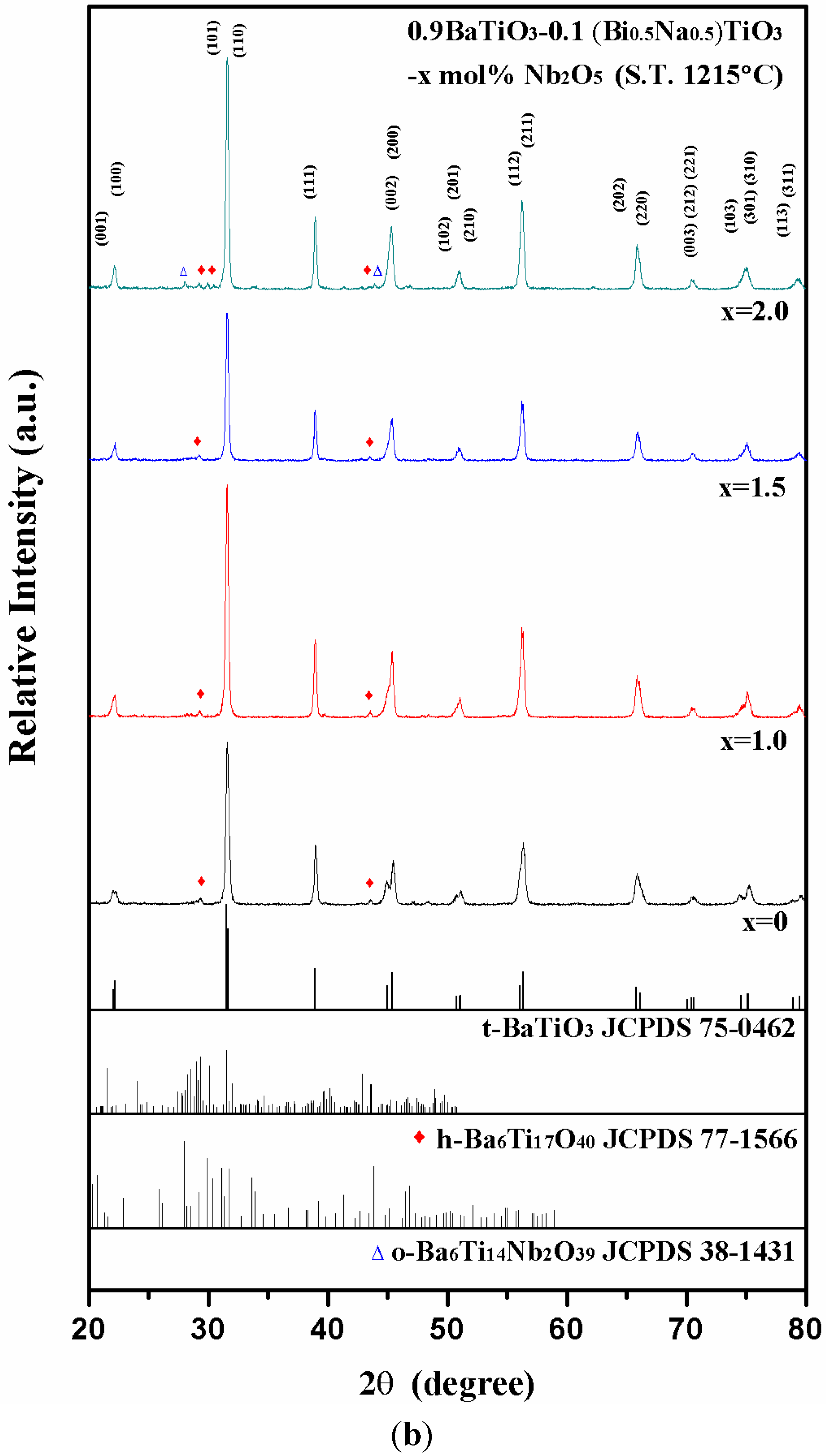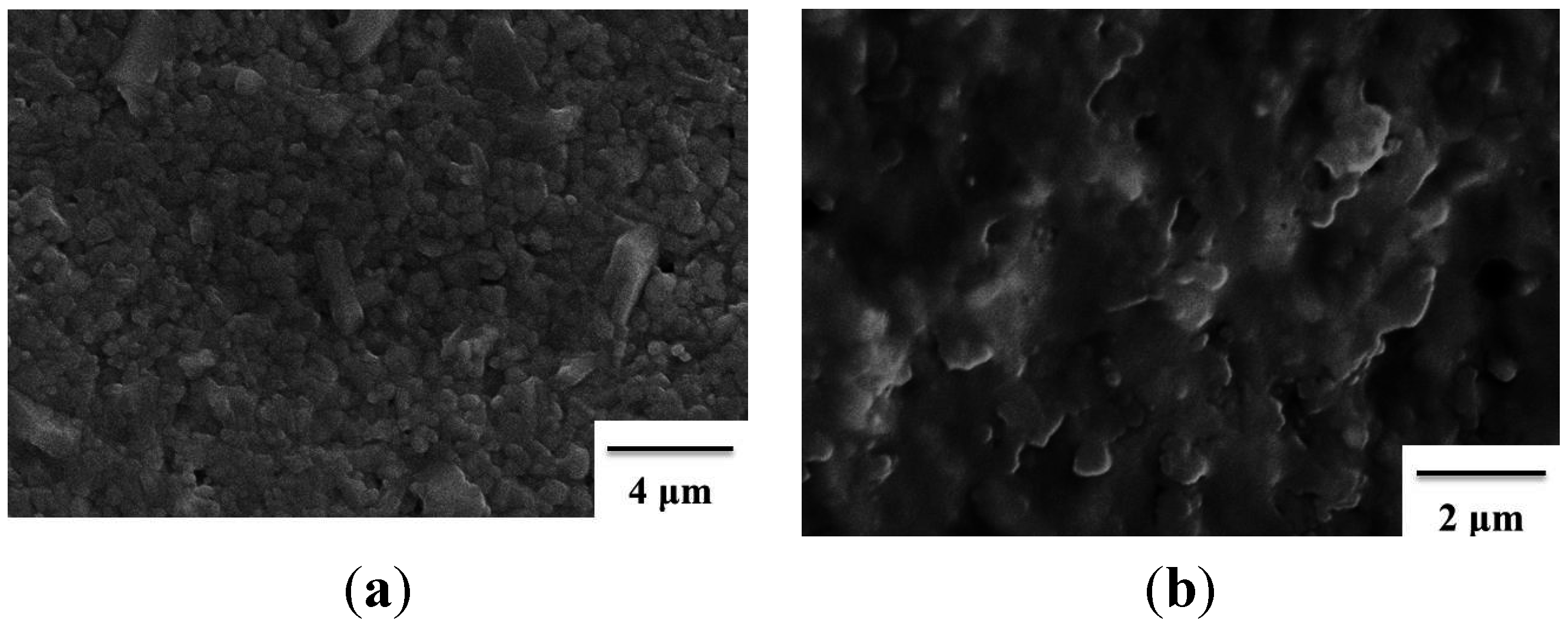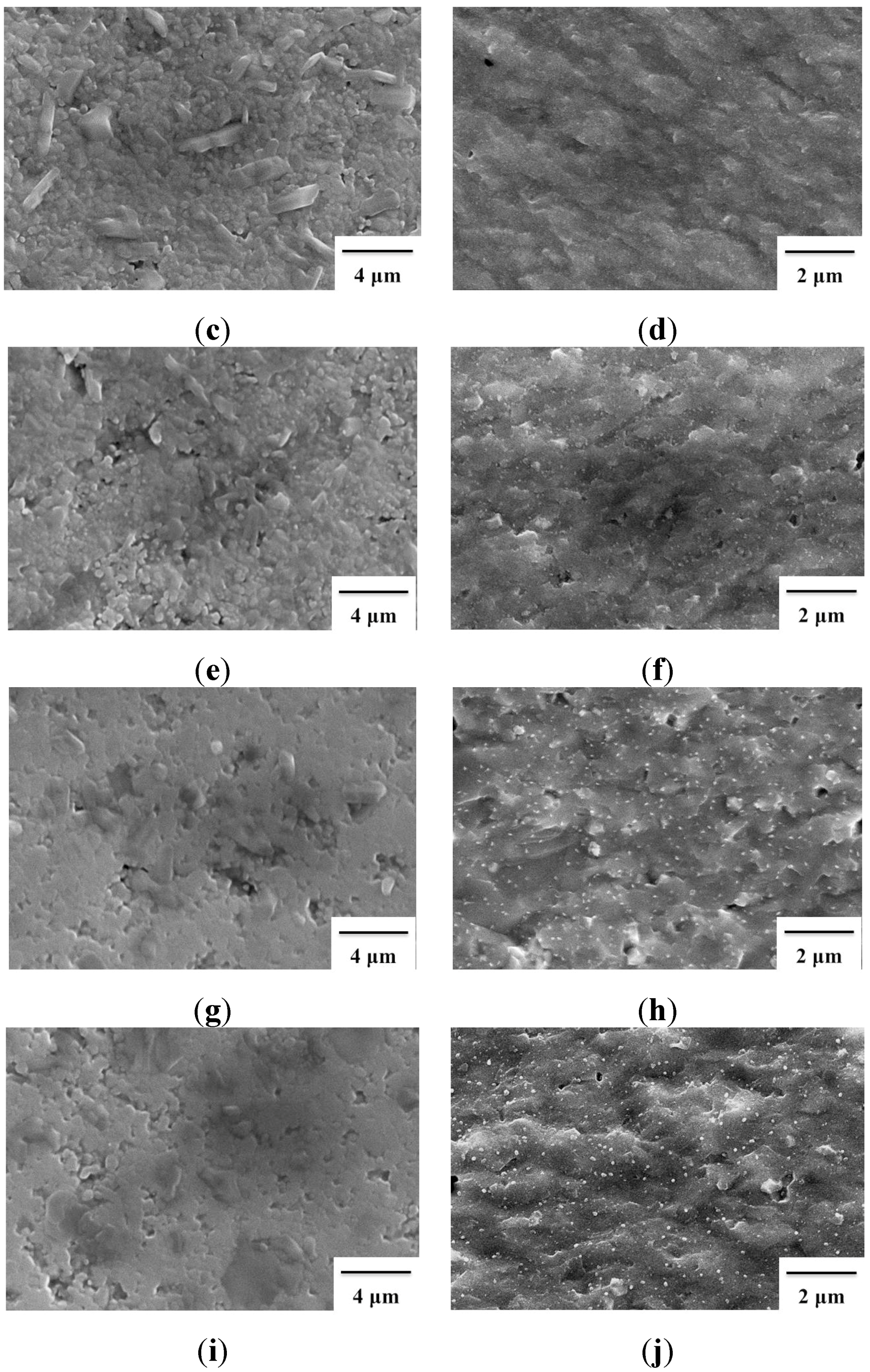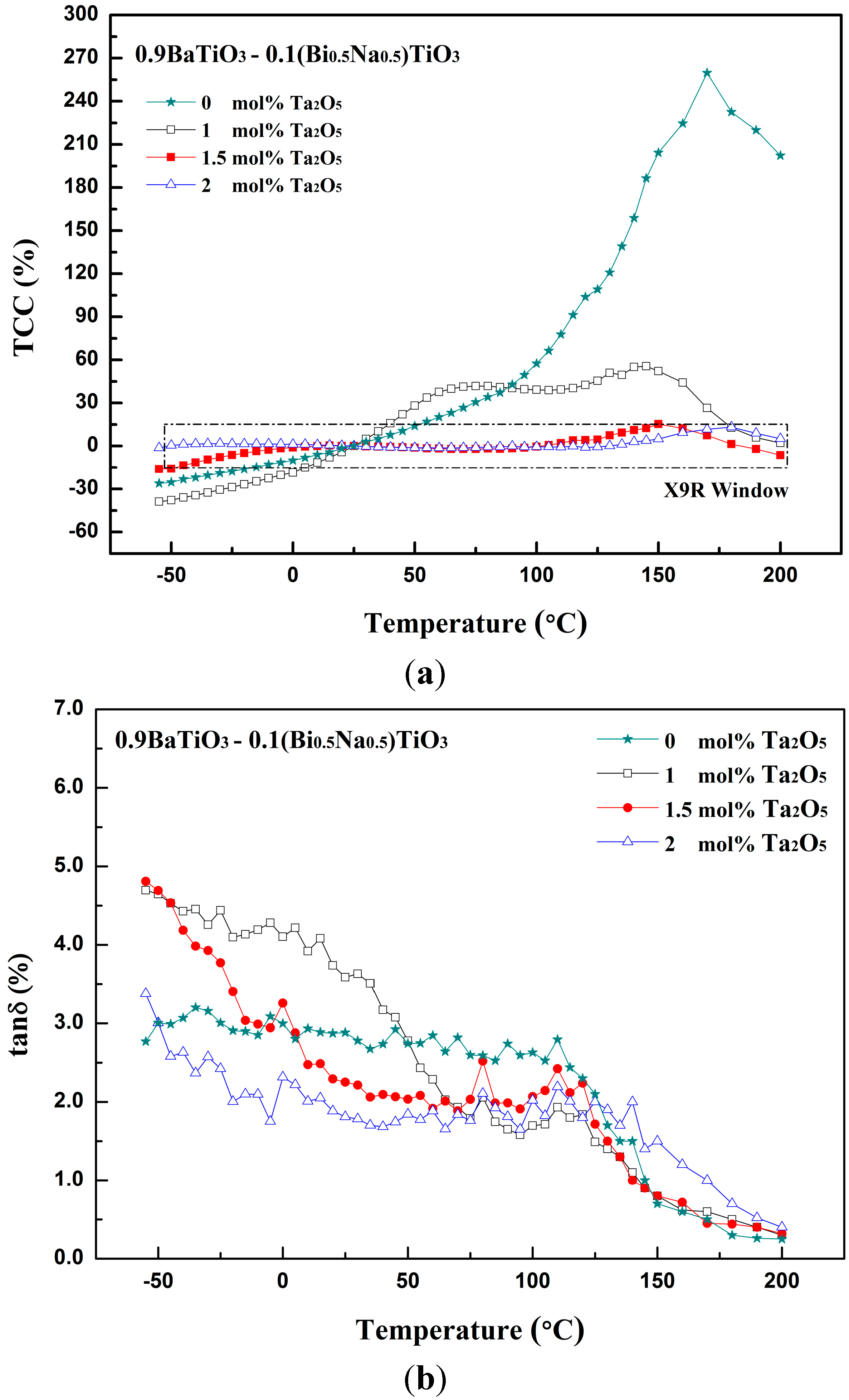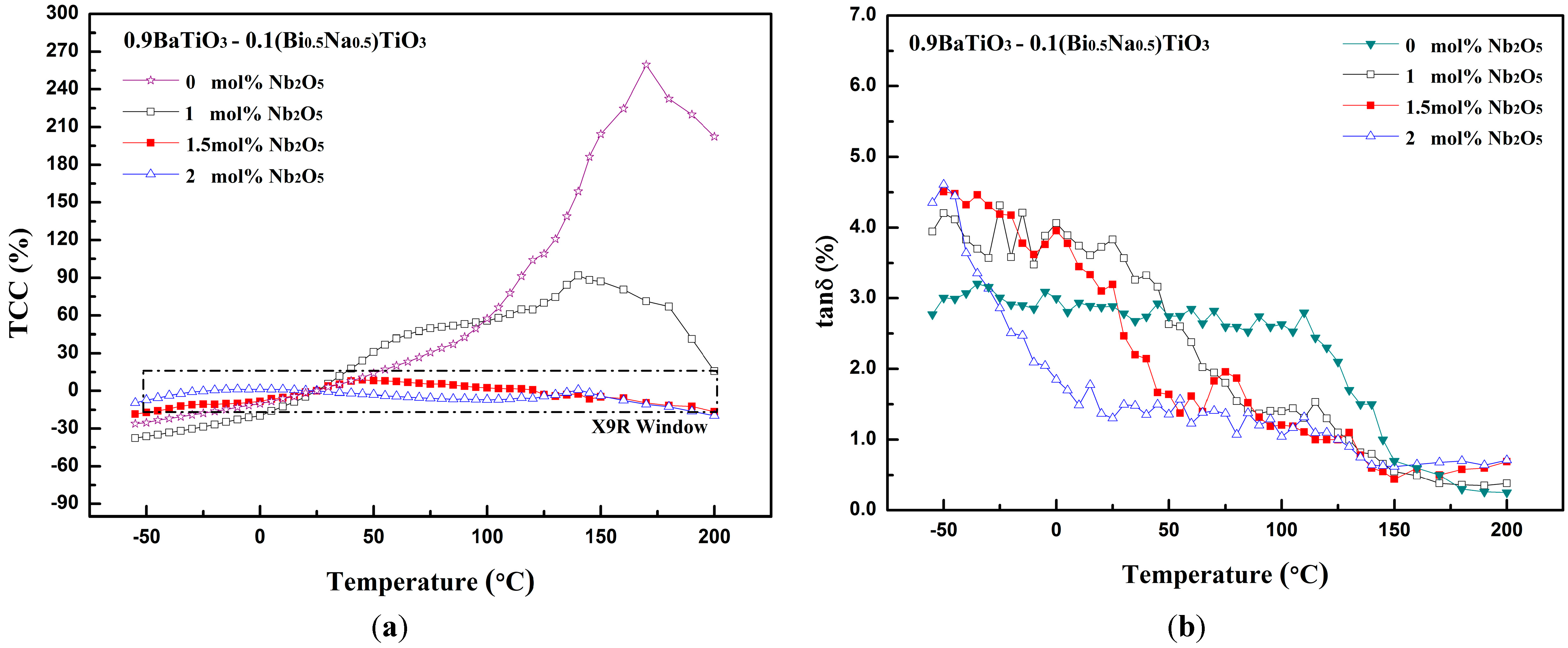1. Introduction
Multilayer ceramic capacitors (MLCCs) are crucial electronic components used in virtually every area of electronics, and the number and variety of their applications have steadily grown. During the past decade, MLCC manufacturers have been driven to accelerate progress in miniaturization, enhancement of volumetric efficiency, reinforcement of stability and reliability against environment, and cost reduction, none of which can be achieved without an improvement in materials formulation and processing technology. The compositions of most ceramic capacitors are based on ferroelectric barium titanate (BaTiO
3) materials. BaTiO
3 can be either chemically or physically modified to exhibit the required temperature-stable dielectric behavior [
1].
MLCCs used in automobile electronic parts, such as anti-lock brake systems, engine electronic control units, crank angle sensors, and programmed fuel injections, are exposed to high-temperature working conditions of greater than approximately 130 °C in the engine room of an automobile. MLCCs with X8R specifications (X8R: −55 °C to 150 °C, ∆C/C
25 °C ≤ ±15%) were developed to satisfy this requirement. Because of the dramatic variation in permittivity of BaTiO
3 ceramics above the Curie temperature (
Tc ≈ 125 °C), the X8R formulation makes use of the core–shell structure to retain the temperature-stable characteristic by adding rare earth elements with a smaller ionic radius, such as Tm, Yb, Lu, Sc, Er, and Y, to shift the
Tc to higher temperatures [
2,
3,
4]. Nevertheless, for aerospace, oil drilling, and various other applications, MLCCs in electronic devices must withstand even harsher working environments, typified by temperatures higher than 150 °C. Accordingly, Yuan
et al. and a few other researchers have recently started to work on the development of dielectric formulations capable of satisfying X9R specifications (−55 °C to 200 °C, ∆C/C
25 °C ≤ ±15%) [
5,
6,
7,
8,
9,
10,
11]. The utilization of an effective Curie-point shifter, such as (Bi
0.5Na
0.5)TiO
3 or PbTiO
3, to increase the
Tc point along with the formation of the core–shell structure was found to be an effective method for obtaining high-temperature stability [
12,
13,
14,
15,
16]. Dielectric formulations, including BaTiO
3-based compositions, such as BaTiO
3–(Bi
0.5Na
0.5)TiO
3 [
5,
7,
8,
14,
17,
18,
19], BaTiO
3–Bi(Zn
0.5Ti
0.5)O
3 [
16,
20], and BaTiO
3–Pb(Ti
0.55Sn
0.45)O
3 [
10] systems, and (Bi
0.5Na
0.5)TiO
3-based compositions, such as (Bi
0.5Na
0.5)TiO
3–BaTiO
3–CaTiO
3 [
6,
9,
21] systems, have been developed recently to meet the temperature coefficient of capacitance (TCC) requirements of the X9R specifications. Another approach was a multi-phase composite consisting of a high-
Tc material and a low-
Tc material. For instance, new X9R dielectrics based on the BaTiO
3–LiTaO
3 compositions reported by Wang
et al. can be sintered in a reducing atmosphere and are compatible with the base metal electrode (BME) process [
22].
In the BaTiO
3–(Bi
0.5Na
0.5)TiO
3 system, (Bi
0.5Na
0.5)TiO
3 shows strong ferroelectricity at room temperature, undergoes a phase transition with a broad dielectric maximum approximately close to 320 °C [
8], and is considered as an ideal material to shift the Curie temperature of BaTiO
3 above 150 °C [
15]. The distortion and deformation of BaTiO
3 structure induced by the substitution of Na
+ and Bi
3+ into Ba sites by (Bi
0.5Na
0.5)TiO
3 addition improves the stable temperature characteristics of the dielectric properties of BaTiO
3. With the addition of Co
3O
4 and Nb
2O
5, the stable dielectric properties of BaTiO
3–(Bi
0.5Na
0.5)TiO
3 were tailored to meet the X9R specification by adjusting the core–shell structure [
14,
15]. It was also shown in the literature that the dielectric properties of BaTiO
3 or bismuth-based compounds can be significantly enhanced with the addition of Ta
2O
5, through tailoring the microstructure, improving densification, and shifting Curie temperature [
23,
24]. In this study, BaTiO
3–(Bi
0.5Na
0.5)TiO
3 dielectric ceramics incorporating various amounts of Ta
2O
5 additive were investigated to enhance their high temperature stability to meet the X9R specifications. The effect of the Ta
2O
5 additive on the densification, crystalline phase, microstructure development, and dielectric properties of BaTiO3–(Bi
0.5Na
0.5)TiO
3 ceramics compared to those of the common Nb
2O
5 additive under the same processing conditions were investigated and are discussed below.
3. Results and Discussion
To determine the best composition of the host (1 −
x)BaTiO
3–
x(Bi
0.5Na
0.5)TiO
3 ceramic, formulations with an
x value of 0.05, 0.1, or 0.2 were prepared and characterized. While the sintering temperature of BaTiO
3 is typically above 1300 °C, the addition of (Bi
0.5Na
0.5)TiO
3 significantly reduced the sintering temperature to 1230 °C for an
x value of 0.05 and to 1215 °C for
x values of 0.1 and 0.2, which was caused by the formation of the liquid phase [
14,
25]. XRD results indicated the presence of the tetragonal BaTiO
3 perovskite phase (tetragonal, P4/mmm; JCPDF 75-0462) with trace amounts of second-phase Ba
6Ti
17O
40 (monoclinic, C2/c; JCPDF 77-1566), which increased with the (Bi
0.5Na
0.5)TiO
3 content. This observation is in accord with those reported in the literature [
25,
26]. In addition, the peaks corresponding to BaTiO
3 in the XRD patterns shifted to lower angles due to the incorporation of the smaller ions Na
+ (VI; 1.02 Å) and Bi
3+ (VI; 1.03 Å) in the Ba
2+ (VI; 1.35 Å) sites. The lattice constants calculated from XRD patterns appeared to be a = 3.991 Å and c = 4.025 Å. The dielectric properties of the (1 −
x)BaTiO
3–x(Bi
0.5Na
0.5)TiO
3 at the maximum density, measured at a frequency of 1 KHz, are listed in
Table 1. The Curie point of the (1 −
x)BaTiO
3–
x(Bi
0.5Na
0.5)TiO
3 increased with the (Bi
0.5Na
0.5)TiO
3 content and was 145 °C, 170 °C, and >200 °C for
x values of 0.05, 0.1, and 0.2, respectively. This increase occurred because Bi–O bonds are weaker than Ba–O bonds, the substitution of Bi
3+ into Ba sites leads to strengthened Ti–O bonds, and more energy is needed to maintain the balance of Ti
4+ displacement in the TiO
6 octahedrons; thus,
Tc increased [
14,
15,
19]. The dielectric constant of (1 −
x)BaTiO
3–
x(Bi
0.5Na
0.5)TiO
3 at 25 °C decreased from 2066 to 677 while the tanδ value increased from 2.9% to 3.5% as the
x value increased from 0.05 to 0.2. The TCC at the cold end (−55 °C) decreased slightly from −20.8% to −24.6%, whereas the TCC at the hot end (200 °C) significantly increased from 27.0% to 641.0%, which was simply due to the increase in
Tc. Because a high dielectric constant, a low tanδ value, and a stable TCC areneeded for X9R materials, the 0.9BaTiO
3–0.1(Bi
0.5Na
0.5)TiO
3 ceramic was selected as the host material to incorporate the Ta
2O
5 and Nb
2O
5 additives in this study.
Figure 1a shows the sintered densities of 0.9BaTiO
3–0.1(Bi
0.5Na
0.5)TiO
3 ceramics with 1.0%, 1.5%, and 2.0% Ta
2O
5 sintered at different temperatures. In all cases, the sintered density increased the sintering temperature, and the maximum densification was reached at 1215 °C. With further increases in sintering temperature, the sintered density gradually declined because of the trapped porosities associated with the fast grain growth and partly the evaporation of the volatile species such as bismuth and sodium. The weight losses of the Ta
2O
5-doped 0.9BaTiO
3–0.1(Bi
0.5Na
0.5)TiO
3 ceramics during sintering were found to be less than 1.5 wt% through careful monitoring in this study, suggesting that the deviations of the sintered compositions from the nominal composition were only slight. The sintered density of the ceramics decreased slightly with an increase in Ta
2O
5 content, though Ta has a high molecular weight than the substituted Ti. For instance, the maximum densities of 0.9BaTiO
3–0.1(Bi
0.5Na
0.5)TiO
3 ceramics with 1.0%, 1.5%, and 2.0% Ta
2O
5 were 5.82, 5.81, and 5.79 g/cm
3, respectively. The results imply that the addition of Ta
2O
5 inhibits the sintering of the host material. As shown in
Figure 1b, the sintered densities of 0.9BaTiO
3–0.1Bi
0.5Na
0.5)TiO
3 ceramics with 1.0%, 1.5%, and 2.0% Nb
2O
5 dopant showed a trend similar to those with added Ta
2O
5. Apparently, both Ta
2O
5 and Nb
2O
5 additives slightly obstructed the densification of the 0.9BaTi O
3–0.1(Bi
0.5Na
0.5)TiO
3 ceramic.
Table 1.
Dielectric properties of (1 − x)BaTiO3–x(Bi0.5Na0.5)TiO3 ceramics at their maximum sintered densities.
Table 1.
Dielectric properties of (1 − x)BaTiO3–x(Bi0.5Na0.5)TiO3 ceramics at their maximum sintered densities.
| Starting Composition | Sintering Condition (°C/h) | Sintered Density (g/cm3) | Tc (°C) | K (25 °C) | tanδ (25 °C) | TCC | Resistivity * (Ω·cm) |
|---|
| −55 °C | 200 °C | 25 °C | 200 °C |
|---|
| 0.95BaTiO3–0.05(Bi0.5Na0.5)TiO3 | 1230/2 | 5.78 | 145 | 2066 | 2.9% | −20.8 | 27.0 | 4.4 × 1012 | 9.2 × 1010 |
| 0.9BaTiO3–0.1(Bi0.5Na0.5)TiO3 | 1215/2 | 5.78 | 170 | 1044 | 3.4% | −26.2 | 202.0 | 7.2 × 1012 | 1.4 × 1011 |
| 0.8BaTiO3–0.2(Bi0.5Na0.5)TiO3 | 1215/2 | 5.82 | >200 | 677 | 3.5% | −24.6 | 641.0 | 1.9 × 1013 | 5.1 × 1010 |
Figure 1.
Apparent densities of 0.9BaTiO3–0.1(Bi0.5Na0.5)TiO3 ceramics with various amounts of (a) Ta2O5 and (b) Nb2O5 sintered at different temperatures for 2 h.
Figure 1.
Apparent densities of 0.9BaTiO3–0.1(Bi0.5Na0.5)TiO3 ceramics with various amounts of (a) Ta2O5 and (b) Nb2O5 sintered at different temperatures for 2 h.
Figure 2a shows the XRD patterns of 0.9BaTiO
3–0.1(Bi
0.5Na
0.5)TiO
3 ceramics with various amounts of Ta
2O
5 sintered at 1215 °C. Only a major phase of tetragonal perovskite was found in the XRD patterns. Several small peaks at around 30° and 43° were due to the Ba
6Ti
17O
40 phase, which was also observed in the pure 0.9BaTiO
3–0.1(Bi
0.5Na
0.5)TiO
3 ceramic. The addition of Ta
2O
5 in the host material did not trigger any additional second phase, implying that the Ta
5+ ions were substituted into the B-sites of the perovskite lattices and the excess Ti
4+ ions caused the formation of the Ba
6Ti
17O
40 phase. It was also found that the peaks corresponding to the perovskite phase shifted slightly to lower angles because of the ionic radius of Ta
5+ (VI; 0.64 Å), which is slightly larger than that of Ti
4+ (VI; 0.605 Å). As revealed in
Figure 2b, for the 0.9BaTiO
3–0.1(Bi
0.5Na
0.5)TiO
3 ceramics with various amounts of added Nb
2O
5 sintered at 1215 °C, the XRD patterns are quite similar to those of the sintered ceramics with Ta
2O
5. However, another second-phase Ba
6Ti
14Nb
2O
39 (orthorhombic phase, Bm21b; JCPDF 38-1431) was observed as the Nb
2O
5 content increased to 2 mol%, in addition to the Ba
6Ti
17O
40 phase. The calculated lattice constants of the sintered ceramics with 2.0 mol% Ta
2O
5 and Nb
2O
5 were a = 3.981 Å and c = 4.068 Å and a = 3.981 Å and c = 4.031 Å, respectively. The larger variation in the lattice constants of the Ta
2O
5-doped ceramic than of the Nb
2O
5-doped ceramic is correlated with the greater solubility of the former dopant in the perovskite structure than the latter. The limited solubility of Nb
2O
5 led to the formation of Ba
6Ti
14Nb
2O
39 precipitates.
Figure 3 shows the microstructures of the sintered surfaces and fracture surfaces of the pure 0.9BaTiO
3–0.1(Bi
0.5Na
0.5)TiO
3 ceramic and those with added Ta
2O
5 and Nb
2O
5 sintered at 1215 °C. All the microstructures of the sintered surfaces were composed of two types of grains: fine equiaxed grains and some enlarge rod-like grains. EDS analysis identified the former as the perovskite phase BaTiO
3–(Bi
0.5Na
0.5)TiO
3 and the latter as the Ba
6Ti
17O
40 phase. The microstructures of the fracture surfaces indicated that all fractures were transgranular mode and revealed the presence of very little porosity.
Figure 3a,b show the sintered surface and fracture surface of the pure 0.9BaTiO
3–0.1(Bi
0.5Na
0.5)TiO
3 ceramic sintered at 1215 °C, which included fine equiaxed grains with an average grain size of 0.57 μm and rod-like grains with a size of approximately 3.2 μm, similar to those reported in the literature [
14]. The microstructures of the sintered surfaces and fracture surfaces of the 0.9BaTiO
3–0.1(Bi
0.5Na
0.5)TiO
3 ceramics with 1.0 and 2.0 mol% Ta
2O
5 sintered at 1215 °C are shown in
Figure 3c,d, and in
Figure 3e,f, respectively. Compared with the average grain size of the pure 0.9BaTiO
3–0.1(Bi
0.5Na
0.5)TiO
3 ceramic, the average grain size decreased slightly with the addition of Ta
2O
5, while the number of intergranular pores appeared to increase. The average grain size of 0.9BaTiO
3–0.1(Bi
0.5Na
0.5)TiO
3 with 1.0% and 2.0% Ta
2O
5 was determined to be 0.55 and 0.46 μm, respectively. The Ta
2O
5 dopant caused a reduction in the grain boundary mobility, which led to a decrease in grain size and an increase in trapped pores. The microstructures of the sintered surfaces of the 0.9BaTiO
3–0.1(Bi
0.5Na
0.5)TiO
3 ceramics with 1.0 mol% and 2.0 mol% Nb
2O
5 sintered at 1215 °C are shown in
Figure 3g,h, respectively; the equiaxed grains had an average size of 0.51 and 0.50 μm, respectively. The Nb
2O
5-doped ceramics appeared to have greater porosity than the Ta
2O
5-doped ceramics. According to
Figure 3i,j, which present the microstructures of the fracture surfaces, many fine second-phase precipitates of approximately 50 nm in size were distributed in the microstructure, which was determined to be Ba
6Ti
14Nb
2O
39 based on the XRD results shown in
Figure 2b. The fine second-phase precipitates suppressed the grain growth because of the pinning effect, which dragged the grain boundaries during sintering.
Overall, it can be concluded that the solubility of Ta2O5 dopant is greater than that of Nb2O5 dopant in the 0.9BaTiO3–0.1(Bi0.5Na0.5)TiO3 ceramic. The addition of Ta2O5 resulted in the lattice expansion of 0.9BaTiO3–0.1(Bi0.5Na0.5)TiO3 ceramic and reduced the grain boundary mobility and thus slightly inhibited the densification. The average grain size slightly decreased and the number of trapped pores increased with increase of Ta2O5 content. In addition to the pre-existing Ba6Ti17O40 phase, the escalation in addition of Nb2O5 in 0.9BaTiO3–0.1(Bi0.5Na0.5)TiO3 ceramic triggered the formation of Ba6Ti14Nb2O39 precipitates with increased quantity. The distributed second phase suppressed the sintered density and generated porosity in 0.9BaTiO3–0.1(Bi0.5Na0.5)TiO3 ceramic.
Figure 2.
XRD patterns of 0.9BaTiO3–0.1(Bi0.5Na0.5)TiO3 ceramics with various amounts of (a) Ta2O5 and (b) Nb2O5 sintered at 1215 °C for 2 h.
Figure 2.
XRD patterns of 0.9BaTiO3–0.1(Bi0.5Na0.5)TiO3 ceramics with various amounts of (a) Ta2O5 and (b) Nb2O5 sintered at 1215 °C for 2 h.
Figure 3.
SEM micrographs of the sintered surfaces (a), (c), (e). (g), and (i) and the fractured surfaces (b), (d), (f), (h), and (j) of 0.9BaTiO3–0.1 (Bi0.5Na0.5)TiO3 ceramic sintered at 1215 °C for 2 h. (a) and (b) are pure 0.9BaTiO3–0.1(Bi0.5Na0.5)TiO3 ceramic; (c) and (d) correspond to the ceramic with 1.0 mol% Ta2O5; (e) and (f) correspond to the ceramic with 2.0 mol% Ta2O5; (g) and (h) correspond to the ceramic with 1.0 mol% Nb2O5; and (i) and (j) correspond to the ceramic with 2.0 mol% Nb2O5.
Figure 3.
SEM micrographs of the sintered surfaces (a), (c), (e). (g), and (i) and the fractured surfaces (b), (d), (f), (h), and (j) of 0.9BaTiO3–0.1 (Bi0.5Na0.5)TiO3 ceramic sintered at 1215 °C for 2 h. (a) and (b) are pure 0.9BaTiO3–0.1(Bi0.5Na0.5)TiO3 ceramic; (c) and (d) correspond to the ceramic with 1.0 mol% Ta2O5; (e) and (f) correspond to the ceramic with 2.0 mol% Ta2O5; (g) and (h) correspond to the ceramic with 1.0 mol% Nb2O5; and (i) and (j) correspond to the ceramic with 2.0 mol% Nb2O5.
Figure 4 and
Figure 5 show the TCCs and dielectric losses
versus temperature, measured at a frequency of 1 kHz, of 0.9BaTiO
3–0.1(Bi
0.5Na
0.5)TiO
3 ceramics with various amounts of added Ta
2O
5 and Nb
2O
5 sintered at 1215 °C, respectively. Some of the dielectric properties, including the Curie point, dielectric constant, and tanδ value at 25 °C and TCCs at both 25 °C and 200 °C, are also listed in
Table 2. The temperature dependence of the 0.9BaTiO
3–0.1(Bi
0.5Na
0.5)TiO
3 ceramics became flattened with an increase in the dopant contents of Ta
2O
5 and Nb
2O
5. The TCC curves near the Curie point were dramatically suppressed, and a broad and diffuse phase transition occurred in all samples, leading to smooth dielectric temperature characteristics over a relatively broad temperature range (−55 to 200 °C). The temperature corresponding to the maximum of the diffuse phase transition (
Tm) increased with the Ta
2O
5 content, but there was no visible change with an increase in the Nb
2O
5 content. For instance,
Tm corresponding to the 0.9BaTiO
3–0.1(Bi
0.5Na
0.5)TiO
3 ceramics with 1.0, 1.5, and 2.0 mol% Ta
2O
5 content appeared to be around 145 °C, 150 °C, and 180 °C, respectively, while those with 1.0, 1.5 and 2.0 mol% Nb
2O
5 had a similar
Tm of approximately 140 °C. It is apparent that the Ta
2O
5 content can effectively elevate the
Tm of the sintered ceramics.
Figure 4.
(a) TCCs and (b) dielectric losses versus temperature of 0.9BaTiO3–0.1(Bi0.5Na0.5)TiO3 ceramics with various amounts of Ta2O5 sintered at 1215 °C (measured frequency = 1 kHz; heating rate = 2 °C/min; applied voltage = 1 V).
Figure 4.
(a) TCCs and (b) dielectric losses versus temperature of 0.9BaTiO3–0.1(Bi0.5Na0.5)TiO3 ceramics with various amounts of Ta2O5 sintered at 1215 °C (measured frequency = 1 kHz; heating rate = 2 °C/min; applied voltage = 1 V).
Figure 5.
(a) Temperature coefficients of capacitance and (b) dielectric losses versus temperature of 0.9BaTiO3–0.1(Bi0.5Na0.5)TiO3 ceramics with addition of various amounts of Nb2O5 sintered at 1215 °C (measured frequency = 1 kHz; heating rate = 2 °C/min; applied voltage = 1 V).
Figure 5.
(a) Temperature coefficients of capacitance and (b) dielectric losses versus temperature of 0.9BaTiO3–0.1(Bi0.5Na0.5)TiO3 ceramics with addition of various amounts of Nb2O5 sintered at 1215 °C (measured frequency = 1 kHz; heating rate = 2 °C/min; applied voltage = 1 V).
Table 2.
Dielectric properties of 0.9BaTiO3–0.1(Bi0.5Na0.5)TiO3 ceramic with various amounts of Ta2O5 and Nb2O5 at their maximum sintered densities.
Table 2.
Dielectric properties of 0.9BaTiO3–0.1(Bi0.5Na0.5)TiO3 ceramic with various amounts of Ta2O5 and Nb2O5 at their maximum sintered densities.
| Additives | Sintering Condition (°C/ h) | Sintered Density (g/cm3) | Tm (°C) | K (25 °C) | tanδ (25 °C) | TCC | Resistivity * (Ω·cm) |
|---|
| −55 °C | 200 °C | 25 °C | 200 °C |
|---|
| 1.0 mol% Ta2O5 | 1215/2 | 5.82 | 145 | 1788 | 3.6% | −38.8 | 2.1 | 2.6 × 1012 | 1.3 × 1011 |
| 1.5 mol% Ta2O5 | 1215/2 | 5.81 | 150 | 1800 | 2.3% | −16.1 | −6.4 | 3.5 × 1012 | 8.2 × 1010 |
| 2.0 mol% Ta2O5 | 1215/2 | 5.79 | 180 | 1386 | 1.8% | −1.3 | 5.2 | 2.8 × 1012 | 1.5 × 1010 |
| 1.0 mol% Nb2O5 | 1215/2 | 5.79 | 140 | 1471 | 3.9% | −37.7 | 15.7 | 9.0 × 1012 | 9.1 × 1010 |
| 1.5 mol% Nb2O5 | 1215/2 | 5.77 | 140 | 1790 | 3.1% | −18.4 | −16.5 | 6.2 × 1012 | 5.5 × 1010 |
| 2.0 mol% Nb2O5 | 1215/2 | 5.74 | 140 | 1865 | 1.4% | −9.4 | −19.8 | 7.8 × 1012 | 5.1 × 1010 |
The TCCs of the 0.9BaTiO
3–0.1(Bi
0.5Na
0.5)TiO
3 ceramic with 1.0 mol% Ta
2O
5 at −55 and 200 °C were −38.8% and 2.1%, respectively, which failed to meet the EIA X9R specifications because of the large variation of capacitance between the hot and cold ends (See
Figure 4a and
Figure 5a). As the Ta
2O
5 dopant content in the sintered ceramic increased, the capacitance variation at both −55 °C and 200 °C became flattened. The TCCs of the sintered ceramics became X9R-qualified with 2.0 mol% Ta
2O
5. The TCCs at −55 °C and 200 °C for the sintered ceramics with 1.5 and 2.0 mol% Ta
2O
5 were, respectively, −16.1% and −6.4% and −1.3% and 5.2%. The dielectric constant of the 0.9BaTiO
3–0.1(Bi
0.5Na
0.5)TiO
3 ceramic tended to decrease with the Ta
2O
5 content and appeared to be 1788, 1800, and 1386 for 1.0, 1.5 and 2.0 mol% Ta
2O
5, respectively. However, the dielectric constant increased from 1471 to 1790 and 1865 as the Nb
2O
5 content rose from 1.0 to 1.5 and 2.0 mol%, respectively. Apparently, the dielectric constant increased with the addition of Nb
2O
5 dopant, even though the differences in their microstructures, such as grain size and porosity, seemed to be trivial.
Capacitors for high-temperature applications must possess a low dielectric loss at both room and high temperatures to prevent overheating and failure. As shown in
Figure 4b and
Figure 5b, all samples revealed a similar trend in their dielectric-loss curves. The dielectric losses of the sintered 0.9BaTiO
3–0.1(Bi
0.5Na
0.5)TiO
3 ceramics with Ta
2O
5 and Nb
2O
5 continued to drop with the measurement temperature. For instance, the dielectric loss of the sintered ceramic with 2.0 mol% Ta
2O
5 was 3.3%, 1.8%, and 1.7% at temperatures of −55, 25, and 200 °C, respectively. The dielectric loss did not increase at high temperature, unlike that of most ferroelectric ceramics, where the dielectric loss increases because of the increase in ionic mobility or a ferroelectric-paraelectric transition at high temperatures. The dielectric losses of the 0.9BaTiO
3–0.1(Bi
0.5Na
0.5)TiO
3 ceramic were found to decrease significantly with the addition of Ta
2O
5 and Nb
2O
5. For instance, it decreased from 3.6% to 1.8% and from 3.9% to 1.4% at 25 °C when the Ta
2O
5 and Nb
2O
5 dopant content increased from 1.0 to 2.0 mol%, respectively, which is close to the values for common X7R and X8R ceramics with a similar thickness. The electrical resistivities of the 0.9BaTiO
3–0.1(Bi
0.5Na
0.5)TiO
3 ceramics with added Ta
2O
5 and Nb
2O
5 obtained at 25 °C and 200 °C are also listed in
Table 1. All samples appeared to be good insulators, with resistivities ranging from 2.6 × 10
12 Ω·cm to 9.0 × 10
12 Ω·cm at 25 °C and from 1.5 × 10
10 Ω·cm to 1.3 × 10
11 Ω·cm at 200 °C. There was a decrease of approximately two orders of magnitude in resistivity as the temperature rose from 25 °C to 200 °C.
In this study, it was found that Ta
2O
5 dopant was more efficient to increase the temperature stability of dielectric constant of the 0.9BaTiO
3–0.1(Bi
0.5Na
0.5)TiO
3 ceramic, compared with Nb
2O
5 dopant. Particularly, the host ceramic with 2 mol% Ta
2O
5 dopant hadthe best composition in terms of dielectric properties. The X9R formulations and their dielectric properties were highly repeatable in this study, which was not the case with the lead-based X9R ceramics reported in the literature [
10].
